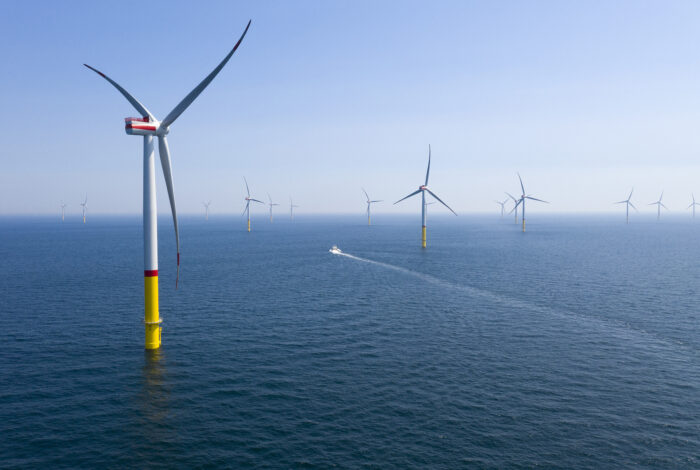(Photo by Scott Eisen/Getty Images)
The Biden administration will seek bids on developing two wind energy sites off Oregon’s southern coast in October.
The announcement on Aug. 29 followed an environmental assessment of the sites off Coos Bay and Brookings by the Bureau of Ocean Energy Management. The analysis found the sites would pose “no significant” impact on people or the environment.
“The advancement of the first offshore wind sale in Oregon marks years of engagement with state partners, tribes, ocean users and industry, and the administration’s commitment to building a thriving and sustainable clean energy industry,” Interior Secretary Deb Haaland said in a release.
The release said the sites could generate more than 3.1 gigawatts of renewable energy if fully developed, enough to power 1 million homes.
The sites would cover 61,200 acres off the coast of Coos Bay and 133,808 acres off the coast of Brookings. The Coos Bay site is 30 miles from the coast and the Brookings area is 20 miles away. The Department of the Interior said the granting of any leases would not constitute approval of development plans. To move forward, they would need to pass an environmental, technical and public reviews, including input from tribes, state and federal agencies and the public.
Five Oregon and California tribes, members of the seafood industry and some locals oppose the developments. Critics said federal officials have failed to be forthright about their plans, and last November, the tribal council of the Confederated Tribes of the Coos, Lower Umpqua and Siuslaw Indians passed a resolution against the sites. It said the bureau had failed to show that the development would not harm the tribes. In November, Coos County residents will vote on a ballot initiative on the development. A coalition of independent fishing boat operators, seafood companies and industry groups also have asked Oregon Gov. Tina Kotek to intervene to stop the development.
Oregon needs to switch from fossil fuels to clean, renewable energy to meet its emission-reduction goals. The current Climate Protection Program by the Department of Environmental Quality – which needs final approval – set a target of reducing emissions from fossil fuels by 50% by 2035 and by 90% by 2050.
Wind energy could inch Oregon towards that goal but it only accounts for a fraction of the state’s energy use. The Oregon Department of Energy’s latest energy report said wind power accounted for 7% of energy consumption in 2000.
A map of the wind energy areas identified for potential offshore floating wind energy farms. (Bureau of Ocean Energy Management)
Nationwide plans
The Bureau of Ocean Energy Management has auctioned five areas off the California coast to develop floating wind energy projects, and it has approved six projects on the East Coast. They’re part of the Biden administration’s plan for up to a dozen offshore wind energy auctions through 2028. The administration is targeting a total of 30 gigawatts of wind energy to be deployed by 2030 – enough to power more than 10 million homes for a year.
Four companies have qualified to bid on Oregon leases: Portland-based Avangrid Renewables, the Spanish companies BlueFloat Energy and Ocean Winds, and the Irish company Mainstream Renewable Power, according to the ocean energy bureau.
Leases are likely to be awarded before Oregon releases its plan for offshore wind development in 2025, and construction would likely take place over the next five years. The projects would need electric transmission systems along the coast to undergo major upgrades.
The state’s planned Offshore Wind Roadmap is part of House Bill 4080 passed this year to lay the foundation for offshore wind energy that complies with labor standards and with community input.
Minor impacts
In its environmental assessment, officials determined that building wind projects in the two areas off Oregon’s Coast would have negligible to moderate impacts on marine mammals and sea turtles due to noise from underwater surveying and potential entanglement in mooring systems and buoys. The most important factors that could affect marine animals and sea turtles, officials said, are vessels striking wind turbine infrastructure. For marine and coastal birds, the potential harm from underwater noise, boat and air traffic, trash and debris and accidental fuel spills were deemed negligible.
Commercial fisheries are likely to experience minor issues related mainly to increased marine traffic while the projects are being built, officials wrote. The companies developing projects would be required to work with local fisheries to coordinate traffic while installation and surveying is underway. Recreational fishing, specifically albacore and tuna fisheries in Coos County or near Coos Bay, could be adversely affected intermittently over a five year term, but the report said officials said they expect a full recovery to recreational fishing once construction is done.
The projects would bring an economic boost to coastal ports and counties by creating jobs and bringing people to the area during construction. But the report said the economic impact would be short term and difficult to measure.
The report identified few economic bonuses for nearby tribes, including the Confederated Tribes of the Coos, Lower Umpqua and Siuslaw Indians, and the agency said it would consult with tribes on any project proposals and would include tribes in the environmental reviews.
This article was first published by the Oregon Capital Chronicle, part of States Newsroom, a nonprofit news network supported by grants and a coalition of donors as a 501c(3) public charity. Oregon Capital Chronicle maintains editorial independence. Contact Editor Lynne Terry for questions: info@oregoncapitalchronicle.com. Follow Oregon Capital Chronicle on Facebook and X.

